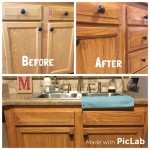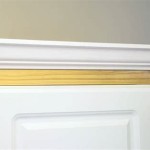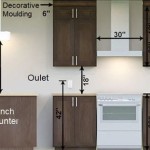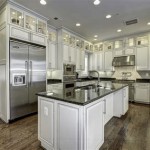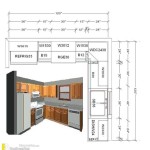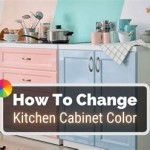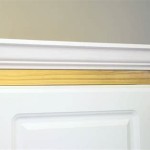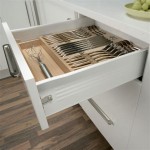Heat Shields For Kitchen Cabinets
Kitchen cabinets located near heat-generating appliances like ovens and cooktops can suffer damage over time. Excessive heat can warp wood, melt adhesives, and discolor finishes. Heat shields offer a practical solution to protect cabinetry from these detrimental effects, preserving their appearance and extending their lifespan.
Key Considerations When Choosing a Heat Shield
Selecting the right heat shield depends on several factors, including the heat source, available space, and desired aesthetics. Careful consideration of these elements ensures optimal protection and seamless integration into the kitchen design.
Types of Heat Shields
Various heat shield materials and designs cater to different needs and preferences. Understanding the properties of each type helps homeowners make informed decisions.
Aluminum Foil Heat Shields
Aluminum foil, a readily available and cost-effective material, can serve as a simple heat shield. Its reflective surface redirects radiant heat away from cabinets, reducing heat absorption. While effective for low to moderate heat levels, aluminum foil may not be suitable for high-heat applications.
Reflective Metal Sheets
Reflective metal sheets, often made of stainless steel or aluminum, provide more robust heat protection compared to foil. These sheets are thicker and more durable, offering superior resistance to high temperatures. Some reflective metal sheets come with adhesive backing for easy installation.
Insulating Heat Shields
Insulating heat shields combine reflective surfaces with insulating materials. This combination effectively reflects radiant heat while also reducing heat transfer through conduction. Insulating heat shields offer the highest level of protection, making them suitable for close proximity to intense heat sources.
Custom-Fit Heat Shields
For a seamless and professional look, custom-fit heat shields offer a tailored solution. These shields are designed and manufactured to precisely fit the dimensions of the cabinets, ensuring optimal coverage and a discreet appearance.
Installation Methods for Heat Shields
Proper installation is crucial for maximizing the effectiveness of a heat shield. Different heat shield types require different installation methods, ranging from simple adhesive application to more complex mounting procedures.
Adhesive Mounting
Many heat shields, particularly those made of thin reflective materials, come with adhesive backing. This allows for quick and easy installation directly onto the cabinet surface. Ensure the surface is clean and dry before applying the adhesive to achieve a secure bond.
Mechanical Fastening
Thicker and more robust heat shields may require mechanical fastening for secure installation. Screws or other fasteners are used to attach the shield to the cabinet or the adjacent wall. This method provides greater stability, especially for larger heat shields.
Magnetic Attachment
Some heat shields utilize magnets for attachment, offering a convenient and removable solution. This method is particularly useful for temporary heat protection or for applications where frequent access to the cabinet is required.
Maintaining Heat Shields
Regular maintenance helps ensure the continued effectiveness of a heat shield. Simple cleaning and inspection procedures can prevent the buildup of grease and debris, preserving the shield's reflective properties.
Cleaning Heat Shields
Most heat shields can be cleaned with a mild detergent and a soft cloth. Avoid using abrasive cleaners or scouring pads, as these can damage the reflective surface. Regularly wipe down the heat shield to remove grease and food splatters.
Inspecting Heat Shields
Periodically inspect the heat shield for any signs of damage, such as warping, tears, or loose attachments. If any damage is detected, promptly repair or replace the shield to maintain its protective function.
Benefits of Using Heat Shields
Integrating heat shields into kitchen design offers several advantages, contributing to the longevity and aesthetic appeal of the cabinetry.
Protection Against Heat Damage
The primary benefit of heat shields is their ability to protect cabinets from heat damage. By deflecting or absorbing heat, they prevent warping, discoloration, and other detrimental effects caused by high temperatures.
Extended Cabinet Lifespan
By mitigating heat damage, heat shields effectively extend the lifespan of kitchen cabinets. This reduces the need for premature replacements, saving homeowners time and money.
Improved Kitchen Safety
Heat shields can also contribute to kitchen safety by reducing the risk of burns from excessively hot cabinet surfaces. This is particularly important in households with children or elderly individuals.
Enhanced Aesthetics
Many heat shields are designed to be discreet and unobtrusive, seamlessly blending into the kitchen design. Some even offer decorative finishes that complement the existing cabinetry, enhancing the overall aesthetic appeal.

Is Your Hot Oven Damaging Kitchen Cabinetry Kool Wrap Heat Protection

How To Fit Heat Deflectors A Guide

How To Fit Heat Deflectors On Your Kitchen Doors
Need Information On A Cabinet Heat Shield Canadian Woodworking And Home Improvement Forum

Heat Shield Cabinets Refrigerators Microwave Tv Oven Kitchen Wood Heater Fire

Best Way To Install Kitchen Heat Shield

Heat Shield Cabinets Refrigerators Microwave Tv Oven Kitchen Wood Heater Fire
Need Information On A Cabinet Heat Shield Canadian Woodworking And Home Improvement Forum

Do I Need Heat Shields

Is Your Hot Oven Damaging Kitchen Cabinetry Kool Wrap Heat Protection
Related Posts

